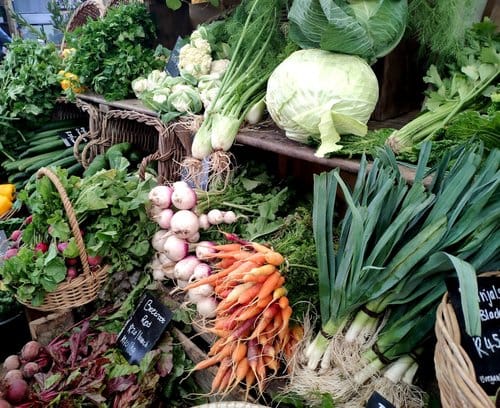This post may contain affiliate links highlighted in blue color for transparency. This means that if you click on one of the links and make a purchase, we may receive a small commission at no extra cost to you. Learn more about the affiliate disclosure. Thank you for supporting our blog!
This article belongs to www.slimdamsel.com
Are you tired of feeling hungry and deprived on your weight loss journey?
Discover the secret to sustainable weight loss with the most filling foods for weight loss.
These nutrient-dense foods will keep you full and satisfied, making it easier to stick to your diet and reach your weight loss goals.
In this article, we’ll reveal the top 3 most filling foods for weight loss, plus tips on how to incorporate them into your diet for maximum weight loss benefits.
Table of Contents
Importance of Feeling Full and Satisfied
Before we discuss about the most filling foods for weight loss, let’s consider why feeling full is important.
Feeling full and satisfied is crucial for several reasons:
- Weight management: Feeling full helps reduce cravings and overeating, leading to sustainable weight loss and maintenance.
- Reduced hunger: Eating filling foods reduces hunger pangs, making it easier to stick to your diet and avoid unhealthy snacking.
- Increased energy: Nutrient-dense foods that promote fullness also provide energy, supporting daily activities and exercise.
- Improved digestion: Foods high in fiber and water content, like fruits and vegetables, support healthy digestion and prevent constipation.
- Better nutrient absorption: When you feel full, your body has time to absorb essential nutrients, supporting overall health and well-being.
- Reduced cravings: Feeling full reduces cravings for unhealthy foods, helping you make better dietary choices.
- Supports healthy habits: Prioritizing fullness and satisfaction encourages mindful eating, portion control, and a balanced diet.
- Reduces stress and anxiety: Feeling full and satisfied can reduce stress and anxiety related to food and eating.
By focusing on feeling full and satisfied, you can develop a healthier relationship with food and support your overall well-being.
Weight control is primarily a hormonal response to certain foods. Hormones send signals to the brain that influence our cravings, hunger and body weight,
Matthew Olesiak, M.D., chief medical director of health technology company SANESolution based in Bellevue, Washington.
But, you may wonder, what’s the essential nutrients needed for someone on a weight loss journey?
Essential Nutrients for Weight Loss
When on a weight loss journey, it’s essential to focus on nutrient-dense foods that provide energy, support overall health, and promote sustainable weight loss. Here are some key nutrients to prioritize:
- Protein: Helps build and repair muscles, regulates appetite, and supports metabolism. Aim for 0.8-1 gram per pound of body weight from sources like lean meats, fish, eggs, tofu, legumes, and dairy.
- Fiber: Supports healthy digestion, satiety, and blood sugar control. Aim for 25-30 grams daily from whole foods like fruits, vegetables, whole grains, and legumes.
- Healthy Fats: Supports energy, brain function, and absorption of vitamins. Nuts, seeds, avocados, olive oil, and fatty fish are great sources.
- Vitamin D: Important for overall health, mood, and weight regulation. Ensure adequate sunlight exposure, supplements, or fortified foods.
- Calcium: Crucial for bone health, muscle function, and appetite regulation. Include calcium-rich foods like dairy, leafy greens, and fortified plant-based milk.
- Iron: Essential for energy production, oxygen transport, and immune function. Red meat, poultry, fish, beans, lentils, and fortified cereals are good sources.
- Potassium: Supports healthy blood pressure, muscle function, and hydration. Include potassium-rich foods like bananas, leafy greens, and sweet potatoes.
- Probiotics: Beneficial bacteria supporting gut health, immunity, and digestion. Find them in fermented foods like yogurt, kefir, kimchi, and sauerkraut.
- Vitamin B12: Vital for energy production, nerve function, and red blood cell formation. Animal products, fortified plant-based milk, and supplements are good sources.
- Water: Adequate hydration supports overall health, digestion, and weight loss. Aim for at least 8 cups (64 ounces) daily.
All of our body processes need water to function—metabolism is one of these processes.
Jamie Feit, a registered dietitian nutritionist and founder of Jamie Feit Nutrition in White Plains, New York.
Remember, a balanced diet with whole foods, variety, and moderation is key. Consult a healthcare professional or registered dietitian for personalized guidance.
The Most Filling Foods for Weight Loss
Without wasting much of your time, let’s proceed to the concept that forms the basis of this article: The most filling foods for weight loss.
As we discuss them, be sure to check out what health experts have to say about them.
1. Leafy Greens

Leafy greens are a powerhouse of nutrition and a great addition to a weight loss diet.
Leafy greens surpass other vegetables in their abundance of vitamins (A, E, K, folate), minerals (calcium, potassium), fiber, and phytonutrients, on a calorie-for-calorie basis.
Registered dietitian nutritionist Jenn Schmidt told Health.
They are:
- Low in calories
- High in fiber
- Rich in vitamins and minerals
- High in water content, making them filling and low in energy density
- Support healthy digestion and bowel movements
- Help reduce inflammation and improve insulin sensitivity
- Support healthy gut bacteria
- Low in carbohydrates
- Support healthy metabolism and thyroid function
Some examples of leafy greens include:
- Spinach
- Kale
- Collard greens
- Lettuce
- Swiss chard
- Arugula
- Watercress
- Bok choy
- Cabbage
- African spinach (also known as Callaloo)
- Mustard greens
- Beet greens
Cabbage is low in calories and high in fiber. Consuming enough fiber is an important part of a diet for weight loss, as it helps you to stay full and provides little in the way of calories.
Jinan Banna, Ph.D., RD
Tips for Incorporating Leafy Greens into your Diet
- Add spinach to your smoothies or salads
- Use kale or collard greens in place of wraps or tortillas
- Add lettuce to your sandwiches or wraps
- Use Swiss chard in soups or stews
- Add arugula to your salads for a peppery flavor
- Use watercress as a garnish or add it to your sandwiches
- Stir-fry bok choy with garlic and ginger for a tasty side dish
- Add cabbage to your soups or stews
- Use African spinach in place of spinach in your favorite recipes
- Add mustard greens to your soups or stews
- Use beet greens in place of spinach in your favorite recipes
We suggested using African spinach in place of spinach because:
- Nutritional similarity: Both African spinach and spinach are packed with nutrients like iron, calcium, and vitamins A and K.
- Versatility: African spinach can be used in many recipes that call for spinach, and its slightly bitter flavor can add depth and complexity to dishes.
- Availability: In some regions, African spinach might be more readily available or affordable than spinach, making it a suitable substitute.
However, keep in mind that African spinach has a stronger flavor, so you may need to adjust the amount used and pair it with ingredients that complement its taste.
2. Cruciferous Vegetables

Cruciferous vegetables are a family of vegetables that are not only delicious but also packed with nutrients and antioxidants.
They are known for their unique flavor and texture, and are a great addition to a weight loss diet. Some examples of cruciferous vegetables include:
- Broccoli
- Cauliflower
- Brussels sprouts
- Radishes
- Cabbage (also listed under leafy greens)
- Bok choy (also listed under leafy greens)
- Kale (also listed under leafy greens)
- Collard greens (also listed under leafy greens)
Population studies have linked a higher dietary intake of cruciferous vegetables like broccoli with a significantly reduced risk of cancer.
Punch
What makes cruciferous vegetables suitable for weight loss?
- Low in calories
- High in fiber
- Rich in vitamins and minerals
- Support healthy digestion and bowel movements
- Help reduce inflammation and improve insulin sensitivity
- Support healthy gut bacteria
- Low in carbohydrates
- Support healthy metabolism and thyroid function
Tips for Including Cruciferous Vegetables into your Diet
- Roast broccoli or cauliflower as a side dish
- Add Brussels sprouts to your salads or sauté them with garlic
- Use radishes in place of cucumbers in salads
- Stir-fry bok choy with garlic and ginger for a tasty side dish
- Add kale or collard greens to your smoothies or soups
3. Legumes

Legumes are a type of vegetable that includes beans, lentils, and peas. They are some of the most filling foods for weight loss due to their high protein and fiber content.
The U.S. Department of Agriculture considers beans and legumes part of both the “vegetable” food group and “protein foods” group, along with meat and fish.
Today
Legumes are also rich in complex carbohydrates, which provide sustained energy and help regulate blood sugar levels.
Examples of legumes include:
- Lentils
- Chickpeas
- Black beans
- Kidney beans
- Pinto beans
- Split peas
- Soybeans
- Peanuts
Eating beans regularly has been shown to help reduce cholesterol, improve gut health, reduce the risk of heart disease and help maintain a healthy body weight.
Frances Largeman-Roth, a registered dietitian nutritionist
Tips for Adding Legumes into your Diet
- Add lentils or chickpeas to your soups or stews
- Use black beans or kidney beans in place of meat in dishes like tacos or chili
- Make a salad with chickpeas, black beans, or kidney beans
- Use legumes as a protein source in place of meat
- Try roasting or sautéing legumes as a side dish
Groundnuts are a good source of protein, fiber, and healthy fats, making them a nutritious and popular snack or ingredient in many dishes.
Here are some tips for incorporating groundnuts (peanuts) into your diet:
- Snack on raw or roasted peanuts as a healthy snack
- Add peanut butter to your smoothies or oatmeal for a protein boost
- Use peanut oil for cooking or making salad dressings
- Add peanuts to your stir-fries or curries for a crunchy texture
- Make a Thai-style peanut sauce for noodles or satay
- Use peanuts as a topping for salads or yogurt
- Make homemade peanut butter by grinding peanuts in a food processor
- Add peanuts to your homemade granola or energy bars
- Use peanut flour as a gluten-free substitute in baking
Remember to choose unsalted and unsweetened options to get the most health benefits from groundnuts!
Conclusion
We have seen that the top 3 most filling foods for weight loss that make up our list are leafy greens, cruciferous vegetables, and legumes.
Including them in your diet can help you feel full and satisfied, making it easier to stick to your weight loss goals.
These foods are not only filling but also packed with nutrients, vitamins, and minerals that support overall health and well-being.
Remember, losing weight is not just about cutting calories, but also about nourishing your body with whole, nutrient-dense foods.
By adding these three food groups to your diet, you’ll be well on your way to a healthier, happier you!
Final Thoughts
- Make sustainable lifestyle changes, not temporary diet fixes
- Focus on adding whole foods, not restricting yourself
- Experiment with new recipes and flavors
- Find healthy alternatives that satisfy your cravings
- Celebrate small victories, like trying a new recipe or reaching a week of healthy eating, and don’t give up! Every small success brings you closer to your weight loss goals and a healthier lifestyle.
Frequently Asked Questions (FAQs)
How much of these foods should I eat to feel full and support weight loss?
Aim to include a serving size of each food group in your meals and snacks. For example, a serving size of leafy greens is about 1 cup cooked or 2 cups raw.
Can I still lose weight if I have a slow metabolism?
Yes! Incorporating these filling foods into your diet can help support weight loss, even with a slow metabolism. Additionally, regular exercise and a balanced diet can help boost your metabolism.
Are these foods suitable for vegetarians and vegans?
Yes! Leafy greens, cruciferous vegetables, and legumes are all plant-based and suitable for vegetarians and vegans. Legumes are a great source of protein for plant-based diets.
How long will it take to see weight loss results?
Sustainable weight loss takes time. Focus on making healthy lifestyle changes and celebrate small victories along the way. Aim to lose 1-2 pounds per week for a healthy and maintainable weight loss journey.
Can I still enjoy my favorite foods while incorporating these filling foods?
Absolutely! Moderation is key. Enjoy your favorite foods in moderation while prioritizing whole, nutrient-dense foods.
This article belongs to www.slimdamsel.com


